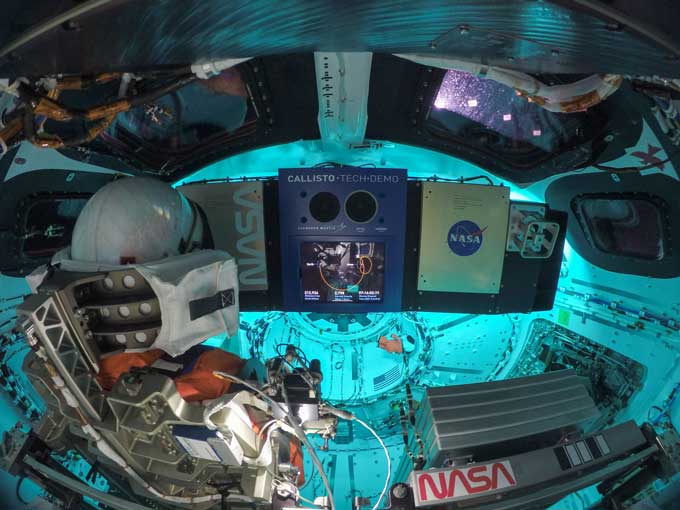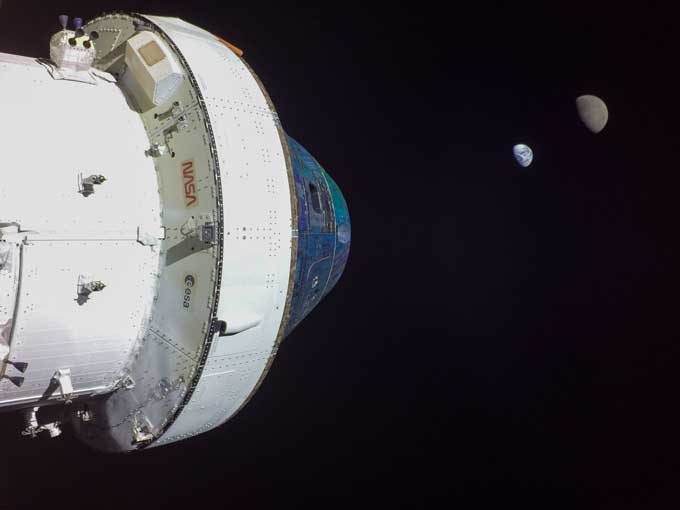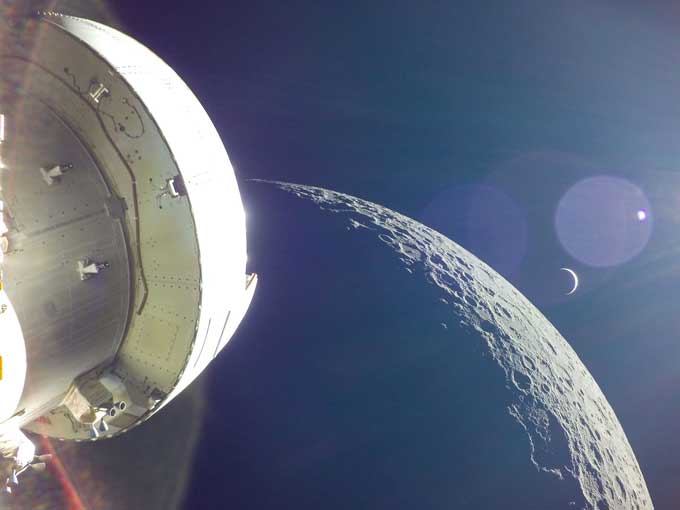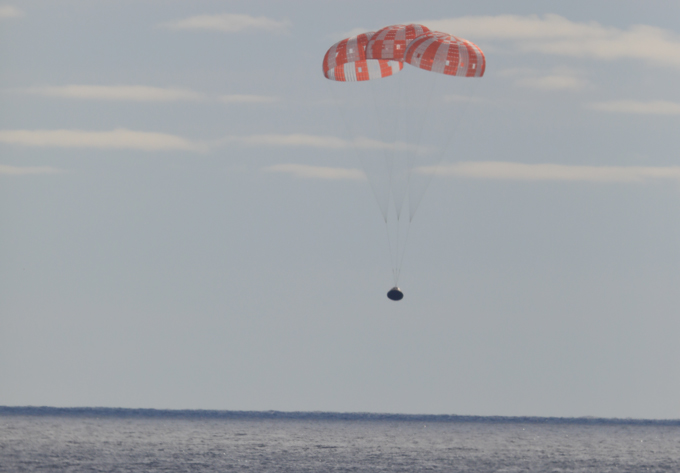Artemis 1’s Orion capsule returned safely to Earth. What’s next?
NASA’s Orion passenger space capsule has passed a huge test, splashing down intact in the Pacific Ocean off the coast of Mexico on December 11. The successful splashdown caps the complex and delayed Artemis 1 mission, which sent Orion around the moon and back in an early test of bringing humans back to the lunar surface.
Now mission scientists will examine the capsule for damage, paying close attention to how its heat shield performed on its searing reentry into Earth’s atmosphere, as well as spots where a prelaunch hurricane damaged the capsule’s caulking. When it entered Earth’s atmosphere, Orion was traveling some 40,000 kilometers per hour, but atmospheric drag and massive parachutes quickly slowed it. The resulting friction heated the spacecraft to nearly 2700⁰ Celsius, fully testing Orion’s heat shield’s ability to protect what’s inside the spacecraft.
Science News headlines, in your inbox
Headlines and summaries of the latest Science News articles, delivered to your email inbox every Friday.
Thank you for signing up!
There was a problem signing you up.
The team will also analyze data from its faux astronaut pilot, Moonikin Campos, and his female torso passengers Helga and Zohar (SN: 8/26/22). Those data will help to determine things like how much radiation and acceleration the real human astronauts will face, how well their protective gear works and how female bodies will fare during the planned launch of a crewed Orion space capsule. That’s scheduled for 2024, when Artemis II will send a crewed capsule to orbit the moon. NASA then aims to land astronauts on the moon as early as 2025 as part of Artemis III.
Some 140 gigabytes of data were already downloaded during the nearly monthlong flight, “but there’s a lot of data that’s stored on the vehicle, particularly for some of the things that were flying inside the crew cabin,” says NASA’s Debbie Korth, Orion deputy program manager.
To prep for Artemis II, “the next step is adding the crew and adding an environmental control and life support system to the Artemis II spacecraft,” Korth says. Several components of the Space Launch System rocket that will launch that next flight are being constructed, and the next Orion crew and service modules are being tested and completed at Kennedy Space Center.
“This was a challenging mission, and this is what mission success looks like,” said NASA’s Mike Sarafin, the Artemis I mission manager of this test flight during a news conference after the splashdown.
Here’s a look back at Orion’s 25.5-day historic trek after its nail-biting launch on November 16 (SN: 11/16/22).
Day 3: Bye-bye, CubeSats
The mission launched with 10 shoebox-sized CubeSats that sat between the rocket’s core stage and the Orion spacecraft. On Day 3, the Artemis I team confirmed that all 10 deployed at their planned times but it appears that about half either didn’t turn on or aren’t operating as expected.
The ones that seem to be working so far include ArgoMoon, the European CubeSat that’s taken photos of the moon and Earth, plus NASA’s BioSentinel experiment, which is testing cosmic radiation’s effect on yeast. NASA’s LunaH-Map CubeSat, which is looking for areas rich in hydrogen and water on the moon’s surface, is functioning, although its propulsion system isn’t working properly.
From astronomy to zoology
Subscribe to Science News to satisfy your omnivorous appetite for universal knowledge.
The Japanese space agency contributed two CubeSats: EQUULEUS is testing water propulsion in space, and it is working as expected, but the nation’s lunar lander, OMOTENASHI, had been in and out of radio contact and its mission was scrubbed.
Orion also did a bit of self-inspection on Day 3, snapping pics of its exterior to check for damage after the first leg of its flight.
Day 4: Radiation test
The sun, which is in its active solar cycle, sent out a pretty big flare on November 19. It was the most energetic flare Orion encountered on its trip (though not even in the top 50 most powerful ones of the year) and a good test of how radiation affects the manikin passengers. Once back on Earth, scientists can analyze the thousands of sensors on those manikins to have a better idea how the radiation will affect humans.

Especially interesting will be the differences between Zohar and Helga. While Zohar is wearing a vest to protect its torso from radiation, Helga isn’t.
Day 8: Can you hear me now?
Mission control temporarily lost communication with the space capsule for 47 minutes on November 23. This happened while Orion was trying to chat with the Deep Space Network, the large radio dishes on Earth that send and receive signals to and from spacecraft.
The team downloaded a bunch of data to try to understand why that happened. They’re trying to figure out if it was a problem on the Orion end or on the Deep Space Network side of things. Other Orion check-ins with the same radio network have worked flawlessly.
Day 10: New orbit
After passing by the moon, Orion entered a new orbit following an engine burn to change its direction. This distant retrograde orbit put the capsule more than 65,000 kilometers above the lunar surface.
It was far enough away from the moon that Orion wouldn’t have to use a lot of fuel to stay stable, allowing the mission team to test how this spacecraft functions in a deep space environment. They plan to test its star trackers — what the team uses to orient the capsule in space — and other parts of its guidance and control systems that can’t be tested on Earth.
Day 13: Breaking a record
Orion reached 432,210 kilometers from Earth, giving it an amazing view of both Earth and the moon.

This wasn’t just Orion’s maximum flight distance, but it’s the farthest any spacecraft designed for humans has gone. It beat the record that’s been in place for more than 50 years, set by Apollo 13 (SN: 7/6/19).
Day 20: Farewell moon
In a farewell kiss, Orion swung just 129.7 kilometers above the lunar surface. Its engineers intended for that flyby to use the moon’s gravitational force to alter the direction of its flight.
The spacecraft also burned its main engine for nearly three and a half minutes to boost its speed.
Those actions let Orion break free of the moon’s sphere of influence, where lunar gravity was the main force acting on it, and direct it back to Earth.

Day 26: Splashdown!
Following a harrowing nearly 20-minute descent through Earth’s atmosphere, skipping through the thick gaseous layers, the Orion crew capsule splashed down in the Pacific Ocean near Guadalupe Island, off the coast of Mexico’s Baja Peninsula.
While it hit the atmosphere at just under 40,000 kilometers per hour, it landed in the water at 32 km/hr, slowed primarily by Orion’s 5-meter diameter heat shield against the atmosphere. Special material that makes up the shield burned off in the atmosphere as friction slowed the craft, carrying some of the intense heat away from the capsule. Then, in the last four minutes of descent, a series of 11 parachutes deployed, helping to plop Orion softly into the ocean.

Mission scientists then checked the temperature in the cabin and outside and took other remote measurements before recovery teams snagged it several hours later and brought it to U.S.S. Portland.
“I don’t think any one of us could have imagined a mission this successful, but we had a very successful flight test,” Sarafin said. “We now have a foundational deep-space transportation system.”
For all the latest Technology News Click Here
For the latest news and updates, follow us on Google News.
